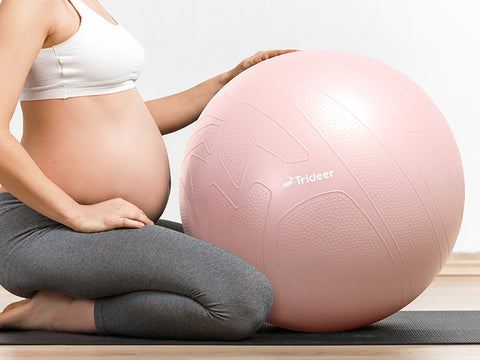Exercise balls or "Swiss balls" are nothing new in the world of fitness and physical therapy rehabilitation. The first ball of its kind was developed by Italian plastics manufacturer Aquilino Cosani in 1963 and was originally named the "Pezzi Ball".
Within a decade of its creation, the ball was being used by physiotherapists across Europe, including a Swiss physiotherapist focused on postural re-education and back rehabilitation. In the 1980s, American physical therapists became fascinated with European methods of rehabilitation and were so impressed with the Pezzi Ball that they brought it back to the United States and renamed it the "Swiss Ball."
What is an exercise ball?
Exercise balls, also known as Swiss balls, therapy balls, balance balls, Pez balls, Pilates balls, yoga balls, therapy balls, or even Swedish balls, mean exactly the same thing. They are used in rehabilitation and fitness and work by forcing the body to balance the instability of the ball, resulting in greater muscle activation. This improves back and spine health, core stability, posture and muscle balance.
In this blog, we explain how an exercise ball can help you and give our top tips:
Medicine Ball Improves Back and Spine Health
Here at Health & Care we are often asked "Is an exercise ball good for your back?"
We all know that exercise balls were invented for this very reason - so we have a variety of options for you to choose from. The exercise ball works to increase overall core strength, stabilize the spine to reduce pain and discomfort, and provide excellent lumbar support. This in turn strengthens the back and helps move the body quickly and efficiently.
Exercise Ball Improves Core Stability
There's a reason a Swiss ball is also called an exercise ball, Pilates ball, or yoga ball. Maintaining core strength is very important because these muscles are the ones in your body that stabilize and support all your movements.
The three muscle groups of the abdomen are:
Deep abdominal muscles (transversus abdominis)
Back muscles that support the lumbar spine (Tultifidus)
Muscles of the lower back that maintain balance in the spine and pelvis (quadratus lumborum)
Training with a medicine ball, whether it's Pilates, yoga, or simple stretches, is an excellent way to work this hard-to-reach, deep-seated muscle group.
Best Exercise Ball for Core Stability
The Pilates -Mad Exer-Soft Ball provides lightweight, portable core strengthening when you need it. The uneven surface forces the core to remain fully engaged, while also activating the rest of the body's muscles, giving you a killer workout.
Exercise Ball Improves Balance
If you don't know what you're doing in the gym, muscle imbalances can happen faster than you think. Muscles need to work together to perform certain tasks, which is why muscle imbalances can lead to poor posture, pain, and multiple injuries. There is a common imbalance between the front and rear muscles, partly because natural daily activities engage your front muscles more than your back muscles, but also partly because people tend to train their abs and neglect their back.
This is often the main cause of low back pain and discomfort. Swiss ball exercises engage your entire core as the ball supports the lower back and other rear muscles during the exercise.
Exercise Ball Improves Posture
A wonderful side effect of strengthening your core and ensuring muscle balance is having a healthy posture. Regular exercise with a ball can help you maintain the natural curve of your spine, which prevents back arching and protects your spine.
Mini Exercise Balls and Their Benefits
Small or "mini" exercise balls work by creating instability that forces the rest of the body to overcompensate by activating many muscle groups. Therefore, they have many great benefits:
1. challenge core
2. enhance coordination
3. improve balance
4. Enhanced stability
Small and easy to move, they can also be used for an extra challenge in many different workouts, including:
Upper body workout, sit ups with exercise ball
Lower body workouts, using medicine balls and pull-ups
core exercise, using a ball to balance the core
Flexibility exercises, using a ball to stretch tight body parts
Coordination training, passing the ball from left to right
Yoga, Pilates, and Barre, using a ball to improve range of motion

Benefits of Large Exercise Balls
A large exercise ball helps make standard workouts more challenging. While significantly less portable than small or mini exercise balls, they work primarily by challenging the body's core strength and balance. Doing so has several benefits for your body:
Strengthens abdominal and back muscles
Improve balance and core stability
Make sure the body is properly aligned
reduce stiffness
reduce fatigue
Although larger in size and thus lighter in weight, they can add a good challenge to different workouts:
Upper body workout, jackknife moves with a ball
Lower body workout, Bulgarian split squat with a ball
Core workout, doing bugs or V passes with the ball
Strength training, decline push-ups with a ball
Flexibility exercise, full body stretch with ball
Find Your Ideal Exercise Ball
Most exercise balls are very similar, and choosing the one that's right for you is simple. All you need to pay attention to is its size (a ball that is the right size should allow you to sit on it with your knees and hips at 90 degrees). By consulting the table below, you should be able to find the right size ball for your height in no time.
Ball Size Ball Height Your Height
Small 45cm (18in) up to 4'10" (145cm)
Medium 55cm (22in) 4'8" to 5'5" (140 - 165cm)
Large 65cm (26") 5'6" to 6'0" (165 - 185cm)
King Size 75cm (30") 6'0" to 6'5" (185 - 195cm)
XX L 85cm (33in) over 6ft 5in (195cm)
Endless benefits
An exercise ball is an inexpensive and very functional piece of equipment that anyone can incorporate into their exercise routine. Whether you're a seasoned fitness buff or a complete beginner, your body will thank you if you do.










